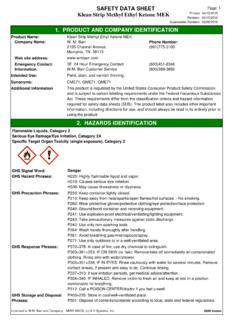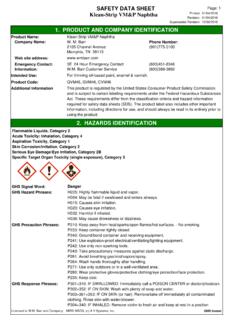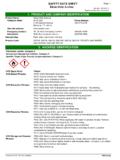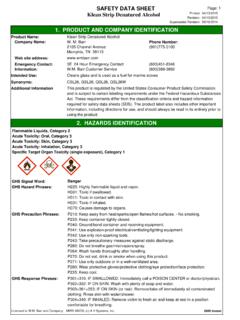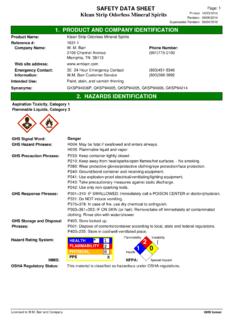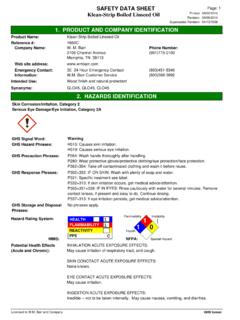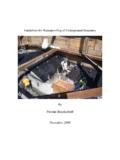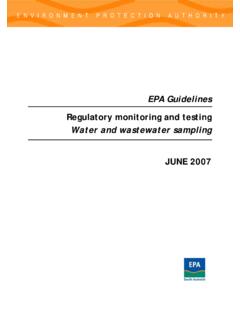Transcription of SAFETY DATA SHEET Klean Strip Paint Thinner Revision ...
1 SAFETY DATA SHEET Page: 1. Klean Strip Paint Thinner Revision : 05/24/2017. Supersedes Revision : 11/16/2015. 1. PRODUCT AND COMPANY IDENTIFICATION. Product Name: Klean Strip Paint Thinner Company Name: W. M. Barr Phone Number: 2105 Channel Avenue (901)775-0100. Memphis, TN 38113. Web site address: Emergency Contact: 3E 24 Hour Emergency Contact (800)451-8346. Information: Barr Customer Service (800)398-3892. Intended Use: Paint , stain, and varnish thinning. Product Code: CKPT94402, GKPT94002B, DKPT94403CA, EKPT94401, GKPT94002, GKPT94002P, GKPT94002T, GKPT94400, PA12779, QKPT94003, QKPT94203, GKPT94002 HDWS, GKPT94002PT, PKPT94004. 2. HAZARDS IDENTIFICATION. Flammable Liquids, Category 3. Acute Toxicity: Inhalation, Category 4. Skin Corrosion/Irritation, Category 2. Serious Eye Damage/Eye Irritation, Category 2B. Germ Cell Mutagenicity, Category 1B. Toxic To Reproduction, Category 2.
2 Specific Target Organ Toxicity (single exposure), Category 3. Specific Target Organ Toxicity (repeated exposure), Category 2. Aspiration Toxicity, Category 1. GHS Signal Word: Danger GHS Hazard Phrases: H226: Flammable liquid and vapor. H304: May be fatal if swallowed and enters airways. H315: Causes skin irritation. H320: Causes eye irritation. H332: Harmful if inhaled. H336: May cause drowsiness or dizziness. H340: May cause genetic defects. H361: Suspected of damaging fertility or the unborn child. H373: May cause damage to Central Nervous System (CNS) through prolonged or repeated exposure. GHS Precaution Phrases: P201: Obtain special instructions before use. P202: Do not handle until all SAFETY precautions have been read and understood. P210: Keep away from heat/sparks/open flames/hot surfaces. - No smoking. P233: Keep container tightly closed.
3 P240: Ground/bond container and receiving equipment. P241: Use explosion-proof electrical/ventilating/lighting equipment. P242: Use only non-sparking tools. P243: Take precautionary measures against static discharge. P260: Do not breathe gas/mist/vapors/spray. P264: Wash hands thoroughly after handling. P271: Use only outdoors or in a well-ventilated area. P280: Wear protective gloves/protective clothing/eye protection/face protection. P281: Use personal protective equipment as required. Licensed to Barr and Company GHS format SAFETY DATA SHEET Page: 2. Klean Strip Paint Thinner Revision : 05/24/2017. Supersedes Revision : 11/16/2015. P235: Keep cool. GHS Response Phrases: P301+310: IF SWALLOWED: Immediately call a POISON CENTER or doctor/physician. P302+352: IF ON SKIN: Wash with plenty of soap and water. P303+361+353: IF ON SKIN (or hair): Remove/take off immediately all contaminated clothing.
4 Rinse skin with water/shower. P304+340: IF INHALED: Remove victim to fresh air and keep at rest in a position comfortable for breathing. P305+351+338: IF IN EYES: Rinse cautiously with water for several minutes. Remove contact lenses, if present and easy to do. Continue rinsing. P308+313: IF exposed or concerned: Get medical attention/advice. P312: Call a POISON CENTER or doctor/physician if you feel unwell. P314: Get medical attention/advice if you feel unwell. P321: Specific treatment see label. P331: Do NOT induce vomiting. P332+313: If skin irritation occurs, get medical advice/attention. P337+313: If eye irritation persists, get medical advice/attention. P362: Take off contaminated clothing and wash before re-use. P370+378: In case of fire, use dry chemical powder to extinguish. GHS Storage and Disposal P403+233: Store container tightly closed in well-ventilated place.
5 Phrases: P405: Store locked up. P501: Dispose of contents/container according to local, state and federal regulations. Flammability Instability Hazard Rating System: HEALTH * 1 2. FLAMMABILITY 2. PHYSICAL 0 Health 1 0. PPE. HMIS: NFPA: Special Hazard OSHA Regulatory Status: This material is classified as hazardous under OSHA regulations. Potential Health Effects Inhalation Acute Exposure Effects: (Acute and Chronic): May cause dizziness; headache; watering of eyes; eye irritation; weakness; nausea;. muscle twitches, and depression of central nervous system. Severe overexposure may cause convulsions; unconsciousness; and death. Intentional misuse of this product by deliberately concentrating and inhaling can be harmful or fatal. Skin Contact Acute Exposure Effects: May cause irritation; numbness in the fingers and arms; drying of skin; and dermatitis.
6 May cause increased severity of symptoms listed under inhalation. Eye Contact Acute Exposure Effects: This material is an eye irritant. May cause irritation; burns; conjunctivitis of eyes; and corneal ulcerations of the eye. Vapors may irritate eyes. Ingestion Acute Exposure Effects: Harmful or fatal if swallowed. May cause nausea; weakness; muscle twitches;. gastrointestinal irritation; and diarrhea. Severe overexposure may cause convulsions;. unconsciousness; and death. Chronic Exposure Effects: Reports have associated repeated and prolonged overexposure to solvents with neurological and other physiological damage. Prolonged or repeated contact may cause dermatitis. May cause jaundice; bone marrow damage; liver damage; anemia; and skin irritation. Medical Conditions Generally Diseases of the skin, eyes, liver, kidneys, central nervous system and respiratory Licensed to Barr and Company GHS format SAFETY DATA SHEET Page: 3.
7 Klean Strip Paint Thinner Revision : 05/24/2017. Supersedes Revision : 11/16/2015. Aggravated By Exposure: system. 3. COMPOSITION/INFORMATION ON INGREDIENTS. CAS # Hazardous Components (Chemical Name) Concentration 8052-41-3 Stoddard solvent {Mineral spirits; Aliphatic <= %. Petroleum Distillates; White spirits}. 25551-13-7 Benzene, Trimethyl- <= %. Additional Chemical Ingredients vary due to multiple blends and/or raw material suppliers Information 4. FIRST AID MEASURES. Emergency and First Aid Inhalation: Procedures: If user experiences breathing difficulty, move to air free of vapors, Administer oxygen or artificial medical assistance can be rendered. Skin Contact: Wash with soap and large quantities of water and seek medical attention if irritation from contact persists. Eye Contact: Flush with large quantities of water for at least 15 minutes and seek immediate medical attention.
8 Ingestion: Do not induce vomiting. Call your local poison control center, hospital emergency room or physician immediately for instructions to induce vomiting. If spontaneous vomiting is about to occur,place victim's head below knees. If victim is drowsy or unconscious, place on the left side with head down. Never give anything by mouth to a person who is not fully conscious. Do not leave victim unattended. Seek medical attention immediately. Signs and Symptoms Of Inhalation, ingestion, and dermal are possible routes of exposure. Exposure: Note to Physician: Call your local poison control center for further information. Inhalation: Inhalation overexposure can produce toxic effects. Monitor for respiratory distress. If cough or difficulty in breathing develops, evaluate for upper respiratory tract inflammation, bronchitis, and pneumonitis. Administer supplemental oxygen with assisted ventilation as required.
9 Ingestion: If ingested, this material presents a significant aspiration and chemical pneumonitis hazard. Induction of emesis is not recommended. Consider activated charcoal and/or gastric lavage. If patient is obtunded, protect the airway by cuffed endotracheal intubation or by placement of the body in a Trendelenburg and left lateral decubitus position. Licensed to Barr and Company GHS format SAFETY DATA SHEET Page: 4. Klean Strip Paint Thinner Revision : 05/24/2017. Supersedes Revision : 11/16/2015. 5. FIRE FIGHTING MEASURES. Flammability Classification: NFPA Class II. Flash Pt: > F. Explosive Limits: LEL: UEL: 6. Autoignition Pt: No data. Suitable Extinguishing Media:Use carbon dioxide, dry chemical powder, or foam. Fire Fighting Instructions: Self-contained respiratory protection should be provided for fire fighters fighting fires in buildings or confined areas.
10 Storage containers exposed to fire should be kept cool with water spray to prevent pressure build-up. Stay away from heads of containers that have been exposed to intense heat or flame. Flammable properties and Combustible Liquid. Hazards: 6. ACCIDENTAL RELEASE MEASURES. Steps To Be Taken In Case Clean up: Material Is Released Or Spilled: Keep unnecessary people away; isolate hazard area and deny entry. Stay upwind, out of low areas, and ventilate closed spaces before entering. Shut off ignition sources;. keep flares, smoking or flames out of hazard area. Small spills: Take up with sand, earth or other noncombustible absorbent material and place in a plastic container where applicable. Large spills: Dike far ahead of spill for later disposal. Waste Disposal: Dispose in accordance with applicable local, state and federal regulations. 7. HANDLING AND STORAGE.
